Guidelines and Publications
- Guidelines for Physicians Working in California Opioid Treatment Programs
- Standards of Care for Adolescent Substance Use
- Standards For Access To Addiction Medicine Services
- Use of Buprenorphine-Naloxone in the Emergency Department
- Insurance Barriers to Accessing Treatment of Opioid Use Disorders Identified by California Physicians
- Minimum Insurance Benefits for Patients with Opioid Use Disorder
- Minimum Insurance Benefits for Patients with Alcohol Use Disorder
- Minimum Insurance Benefits for Patients with Nicotine and Tobacco Use Disorder

Guidelines for Physicians Working in California Opioid Treatment Programs
(Published April 2019)
EDITORS: Walter Ling, MD; Deborah Stephenson, MD, MPH; Ernie Vasti, MD
These guidelines are intended to assist Opioid Treatment Program physicians in understanding their role and responsibilities in treatment, including those areas governed by state or federal regulation. These describe the role of the physician in an OTP and the clinical judgment involved in the development of an appropriate treatment plan for the delivery of patient care. These describe responsibilities that should be carried out by the physician or the physician’s designee. These do not prescribe a standard of care, or specific treatment choices. Judgment regarding specific clinical situations must be made on the basis of the clinical information available and on the treatment options available.

Standards of Care for Adolescent Substance Use
(Adopted by the CSAM Board of Directors October 2017)
Passage of the Adult Use of Marijuana Act (Prop 64) provides California the opportunity and obligation to demonstrate that legal regulation of marijuana can be achieved not only without jeopardizing youth safety but can also improve drug education, prevention, early intervention and treatment of adolescent substance use. An estimated1 164,000 secondary students used marijuana 10 or more days each month (114,000 of whom used marijuana 20+ days per month) and an estimated 72,000 acknowledge binge drinking more than 10 days a month2. Multiple careful studies have established that adolescents are more vulnerable to alcohol, marijuana, tobacco (including e-cigarettes) and other drug-related problems than adults, and documented levels of use prior to implementation of legalized recreational marijuana are cause for concern.
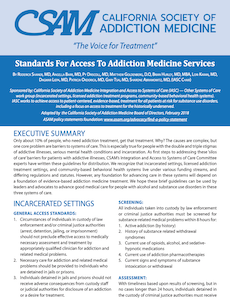
Standards For Access To Addiction Medicine Services
(Updated November 2018)
Only about 10% of people, who need addiction treatment, get that treatment. Why? The causes are complex, but one core problem are barriers to systems of care. This is especially true for people with the double and triple stigmas of addictive illnesses, serious mental health conditions and incarceration. As first steps to addressing these ‘silos of care’ barriers for patients with addictive illnesses, CSAM’s Integration and Access to Systems of Care Committee experts have written these guidelines for distribution. We recognize that incarcerated settings, licensed addiction treatment settings, and community-based behavioral health systems live under various funding streams, and differing regulations and statutes. However, any foundation for advancing care in these systems will depend on a foundation of evidence-based addiction medicine treatment. We hope these brief guidelines can be used by leaders and advocates to advance good medical care for people with alcohol and substance use disorders in these three systems of care.
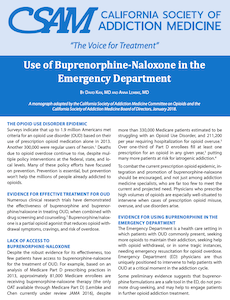
Use of Buprenorphine-Naloxone in the Emergency Department
(Adopted by the CSAM Committee on Opioids and the Board of Directors January 2018)
By David Kan, MD and Anna Lembke, MD
Surveys indicate that up to 1.9 million Americans met criteria for an opioid use disorder (OUD) based on their use of prescription opioid medication alone in 2013. Another 300,000 were regular users of heroin.1 Deaths due to opioid overdose continue to rise, despite multiple policy interventions at the federal, state, and local levels. Many of these policy efforts have focused on prevention. Prevention is essential, but prevention won’t help the millions of people already addicted to opioids.
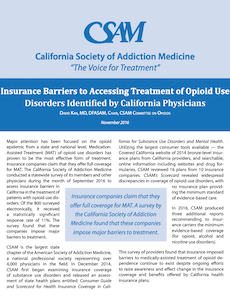
Insurance Barriers to Accessing Treatment of Opioid Use Disorders Identified by California Physicians
(Published 2016)
Major attention has been focused on the opioid epidemic from a state and national level. Medication Assisted Treatment (MAT) of opioid use disorders has proven to be the most effective form of treatment. Insurance companies claim that they offer full coverage for MAT. The California Society of Addiction Medicine conducted a statewide survey of its members and other physicians during the month of September 2016 to assess insurance barriers in California in the treatment of patients with opioid use disorders. Of the 800 surveyed electronically, it received a statistically significant response rate of 11%. The survey found that these companies impose major barriers to treatment.

Minimum Insurance Benefits for Patients with Opioid Use Disorder
(Adopted by the CSAM Committee on Opioids and the Board of Directors August 2015)
By David Kan, MD and Tauheed Zaman, MD
Opioid use disorder has emerged as a worsening, and often deadly, epidemic in the United States. Recent surveys indicate that up to 1.9 million Americans met criteria for an opioid use disorder based on their use of prescription opioid medications alone in 2013, and that another 300,000 were regular users of heroin (SAMHSA 2013). The burgeoning number of ER visits, hospitalizations, and overdoses related to opioids have led several parts of the country to declare states of emergency in combating the epidemic through urgent public health measures.
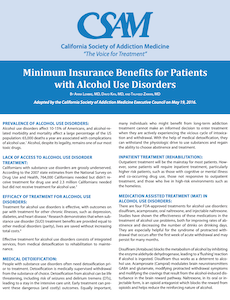
Minimum Insurance Benefits for Patients with Alcohol Use Disorder
(Adopted by the CSAM Executive Council May 2016)
By Anna Lemke, MD, David Kan, MD, and Tauheed Zaman, MD
Alcohol use disorders affect 10-15% of Americans, and alcohol-related morbidity and mortality affect a large percentage of the US population: 65,000 deaths a year are associated with complications of alcohol use.1 Alcohol, despite its legality, remains one of our most toxic drugs.
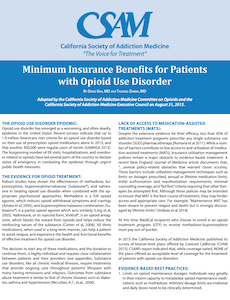
Minimum Insurance Benefits for Patients with Nicotine and Tobacco Use Disorder
(Adopted by the CSAM Executive Council May 2016)
By Smita Das, MD, PhD, MPH, Cathy McDonald, MD, and Lori Karan, MD
Tobacco is the leading preventable cause of mortality in the United States, accounting for 480,000 premature deaths annually.1 Nicotine is the psychoactive drug found in tobacco products and now also in electronic nicotine delivery systems (ENDS) including e-cigarettes. Nicotine is highly addictive, causing physical dependence, tolerance and withdrawal. Nicotine has the highest prevalence of all substance-related disorders in the United States.2 Approximately 17% of the U.S. population are cigarette smokers;3 while smoking rates have declined steadily overall in the US since 1965, prevalence remains high among individuals in addiction treatment, ranging from 77%-93%.4 Annually, tobacco costs the nation at least $130 billion in medical care costs for adults and more than $1,500 billion in lost productivity, accounting for a major economic burden on employers, health plans and government.6 Given the immense health benefits of quitting smoking as well as the public health benefits, quit attempts must be supported.
Guidelines
| Item Name | Posted By | Date Posted |
|---|---|---|
| CSAM Guidelines Chapter 1 PDF (147.27 KB) | Administration | 7/2/2019 |
| CSAM Guidelines Chapter 2 PDF (230.02 KB) | Administration | 7/2/2019 |
| CSAM Guidelines Chapter 3 PDF (102.33 KB) | Administration | 7/2/2019 |
| CSAM Guidelines Chapter 4 PDF (171.99 KB) | Administration | 7/2/2019 |
| CSAM Guidelines Chapter 5 PDF (126.38 KB) | Administration | 7/2/2019 |
| CSAM Guidelines Chapter 6 PDF (785.76 KB) | Administration | 7/2/2019 |
| CSAM Guidelines Chapter 7 PDF (114.59 KB) | Administration | 7/2/2019 |
| CSAM Guidelines Chapter 8 PDF (178.41 KB) | Administration | 7/2/2019 |
| Physicians Guidelines Full PDF (1.35 MB) | Administration | 7/5/2019 |

